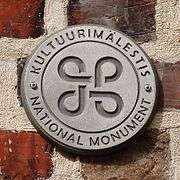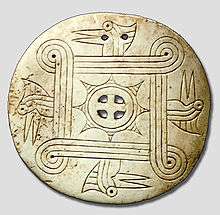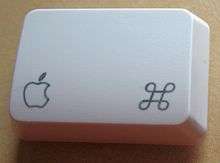Looped square
The looped square (⌘) is a symbol consisting of a square with outward pointing loops at its corners. It is referred to by this name, for example, in works regarding the Mississippian culture.[1] It is also known as the place of interest sign[2] when used on information signs, a practice which started in Finland in the 1950s, spreading to the other Nordic countries in the 1960s.[3] Also, the symbol is known as Saint John's Arms or Saint Hannes cross (related to Swedish sankthanskors, Danish johanneskors, and Finnish hannunvaakuna), as Gorgon loop, and as command key symbol due to its use on the command key on Apple computer keyboards.

It is an ancient symbol used by several cultures, and remains in common use today. It belongs to a class of symbols which are called valknute in Norway.[4]
Ancient use
The symbol appears on a number of old objects in Northern Europe. It features prominently on a picture stone from Hablingbo, Gotland, Sweden, that was created between 400 and 600 AD.[5]
It is also similar to a traditional heraldic emblem called a Bowen knot.[6]
In Finland, the symbol was painted or carved on houses and barns, and domestic utensils such as tableware, to protect them and their owners from evil spirits and bad luck. The oldest surviving example is a pair of 1000-year-old (Finnish pre-Christian period) wooden skis decorated with the symbol.[7][8]
The looped square also appears on artifacts of the Mississippian culture of the southeastern United States.[1]
Modern use

In modern times, the symbol is commonly found in Ukraine, Belarus, Denmark, Estonia, Finland, Germany, Iceland, Latvia, Lithuania, Norway, and Sweden as an indicator of locations of cultural interest, beginning in Finland in the 1950s and spreading to the other Nordic countries in the 1960s.[3] There has been modern speculation that it was chosen for its resemblance to an aerial view of Borgholm Castle;[9] however, as stated its use for attractions began in Finland, not Sweden, and the symbol is well-represented in Scandinavian artifacts that predate the current castle by centuries.[5]
The symbol later gained international recognition via computing. It is used on Apple keyboards as the symbol for the command key[10] as well as in elementary OS as the symbol for the Super key.[11]
Encoding
In Unicode, it is encoded at U+2318 ⌘ PLACE OF INTEREST SIGN (HTML ⌘), in the block Miscellaneous Technical.
Gallery

 Designation for Estonian Cultural heritage monuments
Designation for Estonian Cultural heritage monuments Cox mound gorget (Mississippian culture, found in Tennessee, c.1250–1450)
Cox mound gorget (Mississippian culture, found in Tennessee, c.1250–1450) Cheese moulds in the National Museum of Finland, Helsinki
Cheese moulds in the National Museum of Finland, Helsinki- The ⌘ symbol, Rana museum, Norway

 An Apple command key
An Apple command key
See also
References
- C. Andrew Buchner (2010). "Cox Mound Gorget". Tennessee Encyclopedia. Tennessee Historical Society. Retrieved 9 May 2013.
The Cox Mound, or Woodpecker, gorget style is a … symbol of Tennessee's prehistoric inhabitants. A gorget was a pendant worn around the neck as a badge of rank... thought to be symbolic of both earthly and supernatural powers; A.D. 1250–1450.
- "Miscellaneous Technical – Range: 2300-23FF" (PDF). Unicode Consortium.
- "Riksantikvarieämbetets historia". raa.se (in Swedish). Riksantikvarieämbetet - Swedish National Heritage Board. Retrieved 16 March 2018.
- Municipal arms for Lødingen, blazoned in the Norwegian Royal Decree of 11 May 1984, quoted in Hans Cappelen og Knut Johannessen: Norske kommunevåpen, Oslo 1987, page 197. The term is also used in Anders Bjønnes: Segltegninger fra hyllingene i Norge 1591 og 1610, Oslo 2010, pages 64–65.
- "The Picture Stone from Havor in Hablingbo". Länsmuseet på Gotland. Archived from the original on 13 September 2008.
- Parker, James (1894). A Glossary of Terms Used in Heraldry: Cord. Retrieved 18 March 2007.
- Talve, Ilmar (1990). Suomen kansankulttuuri (in Finnish). ISBN 951-717-553-1.
- Department of Archaeology. "Ski fragment". Nat'l Board of Antiquities (in Finnish). Helsinki: Finnish Museums Online. p. KM9908:1. Archived from the original on 3 December 2013.
- Kare, Susan. "Susan Kare, Iconographer (EG8)". Vimeo.com. Retrieved 25 June 2014.
- Dan Frommer (2 July 2011). "What does Splat mean?". SplatF. Say Media. Retrieved 9 May 2013.
Splat refers to the key on a Mac keyboard that's officially called the Command key. Some old-school Mac nerds — my father included — call it the "splat" key, because the symbol sort of looks like something that went "splat". The symbol itself, also known as Saint John’s Arms or the "place of interest sign"... is often seen in Northern Europe.
- Why the Looped Square (⌘) Symbol?. Medium. 1 March 2018.
External links
